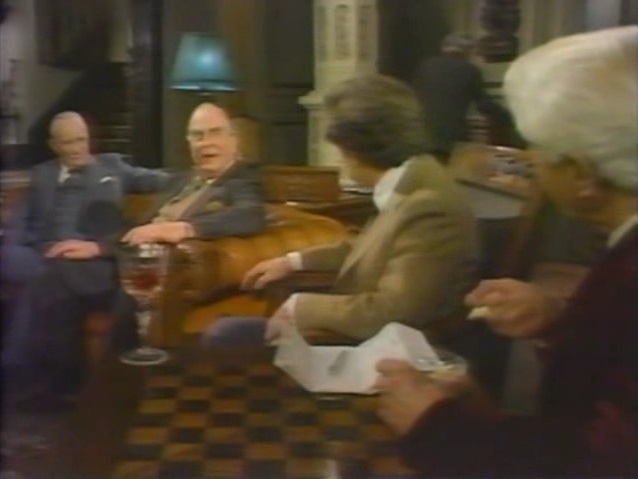A live television broadcast for Hallmark
Hall of Fame with Julie Harris, Christopher Plummer, Hume Cronyn, Jason
Robards, Jr., and Eileen Heckart.
Plummer plays the man as Torvald, all the
way to the closing line.
Schaefer takes the play in a deep analysis
with a very realistic set of a great house in Norway, the camera (there is more
than one) pivots to introduce a character at the door in the background, or out
on the snowy street, not always but regularly enough to prefigure Don
Taylor’s Sophocles epiphanies and Ingmar Bergman’s staging of Miss
Julie, the heroine at the center of a spoked wheel.
The Tempest
Live, and in color, for Hallmark Hall of
Fame.
Ariel is Nijinsky (Roddy McDowall), Caliban
Montgomery Clift (Richard Burton), Maurice Evans the great Prospero, Lee Remick
and William Bassett the lovers, Ronald Radd and Tom Poston the clowns, top
performances.
Pendulum

Question of the law going one way and then
another over the course of the twentieth century, this is somewhat curiously
stated in court (S. John Launer, presiding), there it
is hoped that “gravity” will find a middle course.
The literal representation, subsequently
reflected in Siegel’s Dirty Harry,
finds a confession under duress undermining the case against a violent criminal. Schaefer’s film finds its own mirror in the
arresting officer’s wife working for a public relations firm, an old
flame in shipbuilding resurfaces with an account. These
two are shot to death in her bed while the officer, a highly-decorated
Washington D.C. detective captain, is away in Baltimore making a speech on
behalf of a senator with whose law-and-order subcommittee he is on detached
duty. It is then a question of the unseen murderer
being by suggestion either the jealous captain or the freed criminal, a capital
construction (cf. Godard’s Le Mépris, e.g.), as principal suspect the captain
retains to defend him (“because he’s the best there is”) none
other than the attorney whose plea before the Supreme Court proved a
“landmark”, his name is Woodrow Wilson King, Woody.
Schaefer is an extremely attentive director
to his surfaces, including his actors’ faces, and films extensively in
and around the nation’s capitol, both are in his survey, the thing in
itself and what it reveals at every moment, thus the psychology of the
marriage, colleagues on the force, the senator’s office, the Hitchcockian
motif of the criminal’s stay in Pittsburgh with his mother, the courtroom
and so forth, to descry the springs of action or of thought.
A confab at the Jefferson Memorial between
lawyer, captain and senator, “a ridiculous place to have a
meeting,” says the latter. The D.C. Morgue holds
a fortuitous rendezvous of widow and widower refracted at another angle in
Pollack’s Random Hearts, she is
accusatory.
The screenplay is by another officer of the
Perry Mason court, and culminates in
the high poetry of this exchange, “Woody, this is a damn lousy business. On one hand you got the people and the press screaming and
yelling to clean up the streets, get tough with the kids, toss the criminals in
jail, then on the other hand we’ve got you civil
liberties people screaming and yelling.”
“Oh, come on, we don’t scream
and yell.”
“Yes,
screaming and yelling about people’s rights, immunities and privileges. Then once in a while a cop, sometimes a good cop, gets
himself in a jam, then we’ve got ‘em all down on us. What’s the answer, Woody? How can we do a
good job and keep everybody happy?”
“If everybody were happy you
wouldn’t have a job.” A film of the profoundest discernment with
Hitchcock’s cinematographer Lionel Lindon and a
title song from Walter Scharf and Mack David, sung by
The Lettermen.
Roger Ebert (Chicago Sun-Times), “if you really analyze it, it’s a
fascist movie.” Catholic News Service Media
Review Office, “fast-paced crime thriller”. Dan
Pavlides (All
Movie Guide), “engaging murder mystery.” Halliwell’s Film Guide, “not very interesting.”
F. Scott Fitzgerald and
“The Last of the Belles”
The second part of the title is a story of
the Great War very close to Losey’s Accident as filmed, the rest
is a circumstantial account of its writing that suggests the resumption of
hostilities.
The key is somewhat different, a Northern
rube and streetcar conductor tells the upwardly-mobile dame where to get off,
figuratively.
An Enemy of the People
One of those plans to save the town turns
out to be noxious, the one witness to this suffers ostracism.
The strange constellation of pressures
brought to bear is uncannily accurate. Schaefer is remarkably candid on this
point with a title giving the year of first performance a century earlier.
The film was pleasingly treated in much the
same way as its hero.
The
Deadly Game

Three lawyers and a civic functionary
exercising their skills in retirement after dinner on a cold night with the odd
stranger.
Death of a salesman (“the exclusive
European agent”) four hours from Geneva, a certain Trapp, did the boss in
to get the job. High in the Swiss Alps, the tribunal
of conscience or consciousness (cf.
Maximilian Schell’s End of the Game). “I can’t remember when it was so cold, not
since that winter of ‘45.” A certain
Wilson...
Arraignment of the widow, “too busy
running around with a—some crazy poet down in SoHo.” Cf. Arthur
Penn’s Dead of Winter.
Direction purely theatrical which is to say
dramatic on the realistic set, videotaped straight through as it were without
cinematic resources which is to say pictorial or reflective extraordinarily,
adding a view from the back of the hall before and after each of the two acts,
“as presented on the stage” from a novel by Friedrich Dürrenmatt, Die Panne, initially a play for radio, then television.
Right of Way
Vic ‘n Sade do themselves in, but
surrealistically it’s an object lesson for their unmarried daughter.
Bette Davis and James Stewart have the
roles, terrifically.
John J. O’Connor pooh-poohed the
thing in the New York Times because the characters are witty, the
direction is able, and he thought he ought to.